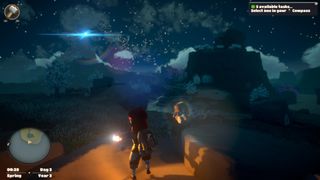Yonder: The Cloud Catcher Chronicles is a beautiful adventure where nothing dies
Though you can chop down trees and rip up grass, if you want.
Here are a few important facts about Yonder: The Dream Catcher Chronicles. Firstly, nothing dies in it. Nothing can be killed. You can’t wield a sword or a gun or even a damn pebble. Secondly, it’s probably the least urgent game I’ve ever played. Nothing feels pressing, nothing feels like it must be done immediately… it feels like a relaxation sandbox more than anything else.
The game is set on Gemea, a lush green island troubled by a phenomenon called the Murk. This Murk covers regions of the map, and it can removed with the help of Sprites – floating Pokemon-esque creatures – thus opening up new regions and objectives.
You’ll need a certain number of these Sprites in order to remove specific regions of Murk, so count “looking for sprites” among the list of things you’ll be doing in Yonder. (And no, you can’t simply throw a grenade at the Murk, or spray it with bullets because, as I mentioned before, there’s no violence allowed!)

These Sprites are pretty central to the game. You’re a Sprite-seer after all, but in addition to finding and befriending these creatures, you also appear to be a protector of them. At least, an otherworldly figure known as Aaerie gave me that impression. Later, I was asked to clear Murk from a large section of the island apparently belonging to said Sprites (not that there’s anything to hurt them elsewhere), a demand I promptly ignored in order to go herd Groffles instead.
This game is very beautiful. In screenshots and videos it looked nice in a kind of canned, desperate-to-ape-Nintendo kind of way. I had cynically expected it to look characterless and derivative when I booted it up. But no, it’s damn beautiful: the grass is a luminous shade of green that only exists in dreams and anime, while the character models and animals are so gorgeous it’s almost risible. Even the weather transitions are lovely, and Gemea’s twilight is dotted with strange glows and grand, mysterious silhouettes. The art style is derivative – of Wind Waker especially – but not in a hollow manner. Even if you don’t like this game – and many won’t – it’s hard to make the claim that it lacks personality.
But what do you do, other than enjoy the scenery? Well, it depends on your mood: the moment-to-moment gameplay in Yonder will either feel like a whole lot of busywork, or a whole lot of relaxing activities. Your playable-character must complete quests in order to acquire tools they will need along the way: axes (for wood), hammers (for rocks) sickles (for grass). And eventually, after a bit of dilly-dallying, after a bit of doing-other-people’s-bidding, you’ll be able to start your own farm.
After these preliminary acquisitions, however, the pressure is emphatically off. Do you want to go and collect a bunch of stuff for a villager, or do you want to improve your farm? Or maybe you’d like to plant some trees? Or maybe you’d like to chop some trees down – the latter being the most volatile action you can enact in this game. Indeed, when you approach destructible crates you’re prompted to “interact” with them, rather than “smash” or “destroy” or “annihilate” them. There is no RPG numbers grind in Yonder, no evil to smite (the Murk is a seemingly neutral environmental phenomenon – a mere inconvenience), but among the most satisfying activities is simply unlocking new areas of the map, ie, building a bridge once you’ve collected the right amount of resources.
PC Gamer Newsletter
Sign up to get the best content of the week, and great gaming deals, as picked by the editors.

Don’t be fooled into thinking this is like Zelda crossed with Stardew Valley though. It’s not. Building a farm and luring Gemea’s amusingly squishy-looking creatures into it (with food and love) is not a complex enterprise, nor are the little bits of micromanagement you’ll pull off to maintain it. As soon as Yonder looks like it might start to get too high-maintenance, it reigns everything in. Farms can only be built in predetermined areas and they can’t expand out of these areas, so they’re really just a pleasant pastime more than a means to achieve anything.
And yeah, achieving things is possible in this game – completing quests, planting trees, capturing squishy creatures – but it doesn’t feel like you’re ever working towards anything of much note. Yonder is just an environment to spend some time in and, usually, my tastes don’t abide that kind of listlessness. But I liked Yonder. I found it annoying sometimes – especially when you talk to a villager and they invite you to go collect useless stuff for them – but I felt compelled to explore anyway. I ran around like a twerp, searched for Sprites, collected shampoo, and sometimes jumped off cliffs when the brazen lack of in-game violence got too much.
Yonder: The Dream Catcher Chronicles is a peaceful game with a benevolent air, which only makes the demand that you slow down enough to match its pace. It’ll be a nice thing to return to when your blood pressure is high, and a great source of calm and comfort, if you need it.
Shaun Prescott is the Australian editor of PC Gamer. With over ten years experience covering the games industry, his work has appeared on GamesRadar+, TechRadar, The Guardian, PLAY Magazine, the Sydney Morning Herald, and more. Specific interests include indie games, obscure Metroidvanias, speedrunning, experimental games and FPSs. He thinks Lulu by Metallica and Lou Reed is an all-time classic that will receive its due critical reappraisal one day.
Most Popular


